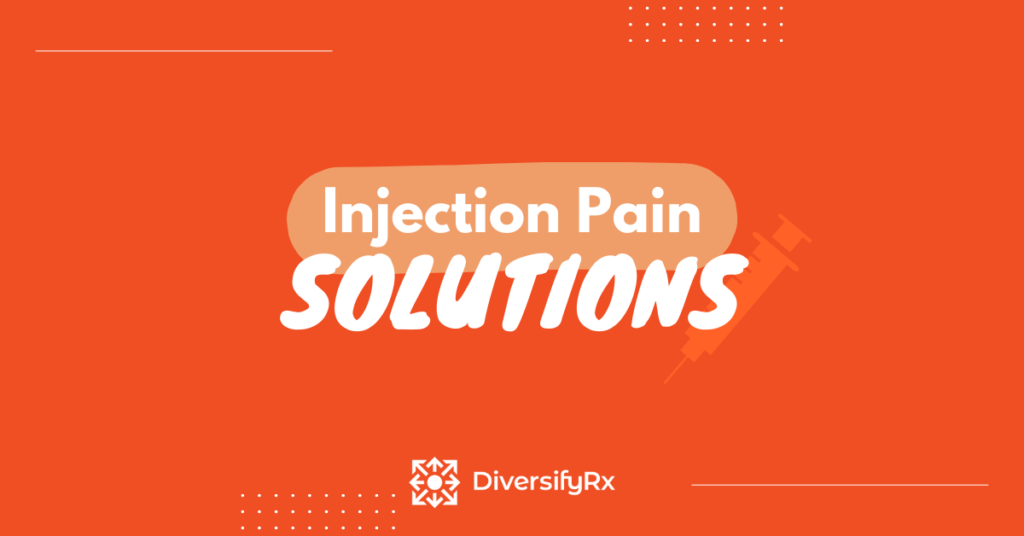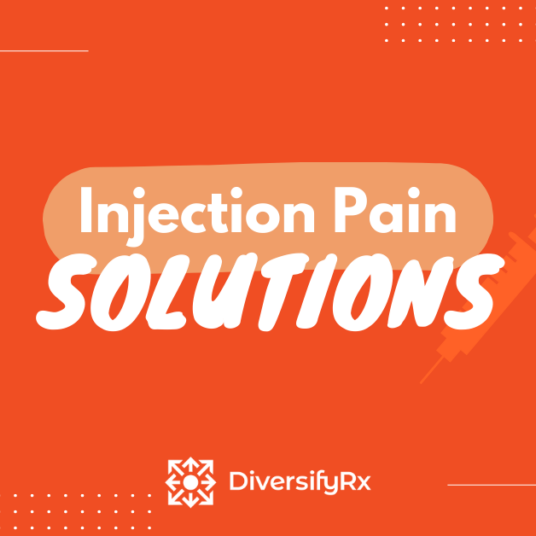Some patients may complain about injection stinging pain. Here’s what to do about it.
Some patients may get a stinging sensation when they inject medication. This injection stinging pain is often referred to as a “hot shot.” Let’s explore some practical solutions to alleviate injectable medication discomfort and ensure a better patient experience.
Understanding What’s Causing the Injection Stinging Pain
There are different sensations when injecting any drug. The poke of the needle, for sure! The pressure from the new volume being injected into the body. Sometimes, there is pain or discomfort from the liquid interacting with the body’s tissues.
If a patient complains of a stinging sensation or pain after injection, this is most often due to a pH mismatch. If the pH of the injectable solution is either too high or too low, it can cause discomfort upon injection. This is a frequent topic in our peptide compounding discussions, as it’s one of the most common side effects patients report. Most patients won’t have an issue.
Let’s dive into troubleshooting the cause of the injection stinging pain if you do run into this problem.
Checking and Adjusting pH
If you’re compounding these injectables in your pharmacy, always check and adjust the pH of your final solution. Ideally, the pH should be as close to neutral (around 7) as possible for peptides.
Here’s how you can do it:
1. Use pH Paper: You might already have pH paper in your pharmacy. If not, it’s readily available online. Place a tiny drop of the solution on the pH paper to check its pH level.
2. Use a pH Meter: I prefer a meter for more precise measuring. Many options are available from compounding wholesalers and even Amazon.
3. Adjust Accordingly: Change the pH to the desired final level with a diluted solution of Sodium Hydroxide or Hydrochloric Acid and add in dropwise until you are happy with the final result.
For those reselling compounded medications from another source, the pH from the supplier could be off. You can always check the pH yourself, to help identify if this is the issue.
Injection Site Matters
The injection site can also influence the patient’s experience. Although scientifically, it might seem that the injection site shouldn’t matter much, real-life experiences suggest otherwise. Encourage patients to try different areas to see if it makes a difference:
1. Change Injection Sites: Some patients find that injecting in their stomach causes stinging, while their leg or arm doesn’t. Encourage them to experiment with different sites to find the most comfortable one.
2. Rotation: Advise patients to rotate injection sites regularly to avoid developing irritation or discomfort in one area.
Temperature Considerations
The temperature of the injectable solution can also play a role. Cold injections straight from the refrigerator can cause discomfort for some patients. Here’s what you can suggest:
1. Room Temperature: Have the patient draw up their dose and let it sit at room temperature for 10-15 minutes before injecting. This can make a significant difference as the solution warms up and becomes more compatible with the body’s temperature.
2. Warming Techniques: Gently rolling the syringe between their hands can also help bring the solution to a more comfortable temperature.
Alcohol and Injection Technique
Another common issue is the use of alcohol before injection. Alcohol can sting if not allowed to fully evaporate before injection:
1. Let Alcohol Dry: Ensure patients are letting the alcohol swabbed on their skin dry completely before injecting. Injecting through wet alcohol can cause a burning sensation.
2. Proper Technique: Encourage patients to puncture the vial after ensuring the alcohol has evaporated. This small step can prevent alcohol from entering the injection site and causing discomfort.
Patient-Specific Factors
Even after addressing pH, injection sites, temperature, and alcohol, some patients may still experience discomfort. Each patient’s body reacts differently:
1. Individual Differences: Some patients might have a naturally higher or lower pH in their bodies, making them more sensitive to injections. This isn’t something that can be easily changed.
2. Managing Expectations: It’s essential to set realistic expectations. Inform patients that a slight tingling or burning sensation is common and usually lasts only a few seconds.
For patients who continue to experience significant discomfort, consider these additional steps:
Pressure and Massage: After administering the dose, suggest applying gentle pressure or massaging the injection site. This can help disperse the medication more evenly and reduce discomfort.
Patient Education: Thoroughly educate patients about these potential side effects and how to mitigate them. Well-informed patients are often more tolerant of minor side effects when they understand the cause and the solutions. This is a crucial aspect of patient care and can significantly improve their experience.
Feel free to reach out if you have any questions or need further guidance on managing injection stinging pain. We are always here to help. Learn more about joining Pharmacy Badass University HERE.



















